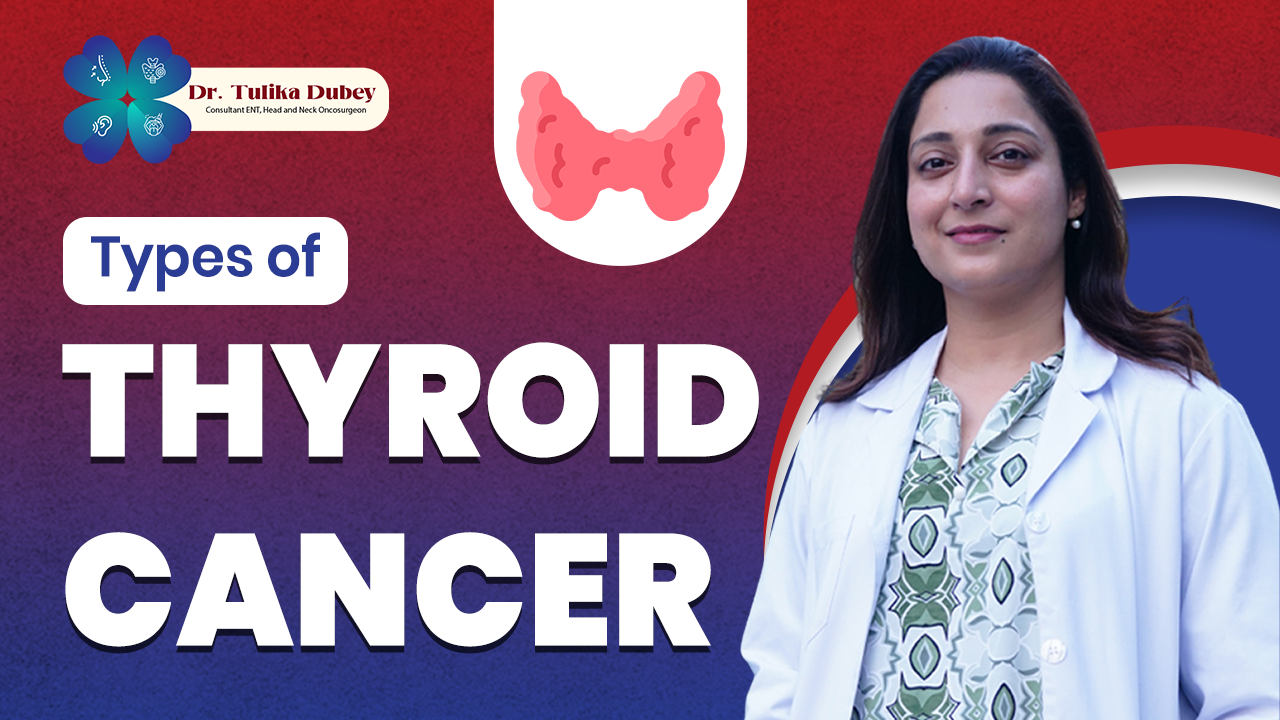Thyroid cancer occurs in the thyroid gland a small, butterfly-shaped organ at the base of your neck responsible for regulating metabolism, heart rate, and body temperature. While most thyroid cancers are treatable and have excellent outcomes, the specific type of cancer significantly influences prognosis and treatment. This guide breaks down all major types, symptoms, diagnosis, management, prognosis, and living guidance.
What Is Thyroid Cancer?
Your thyroid gland, part of the endocrine system, produces hormones that regulate essential bodily functions. Thyroid cancer develops when abnormal cells grow in the thyroid. Though relatively rare compared to other cancers, it has become more commonly diagnosed thanks to improved imaging and biopsies. In the U.S., around 50,000 new cases are diagnosed annually, with approximately 2,000 deaths each year.
Women are diagnosed three times more often than men usually between ages 40–60, though papillary thyroid cancer often appears earlier.
Classifying Thyroid Cancer
Thyroid cancer is grouped by the type of cell it originates from:
Differentiated thyroid cancers: These include papillary, follicular, and Hürthle cell carcinomas. They originate from thyroid follicular cells and tend to grow slowly, often with good prognosis.
Medullary thyroid cancer (MTC): This arises from C-cells, which produce calcitonin, a hormone that helps control calcium levels.
Anaplastic thyroid cancer (ATC): This is an undifferentiated cancer, meaning the cells no longer resemble normal thyroid cells. It is aggressive and often fatal.
There are also rare types such as thyroid lymphoma, sarcoma, and squamous cell carcinoma.
Papillary Thyroid Cancer (PTC)
- Prevalence: Papillary thyroid cancer is the most common form, accounting for 75–85% of all thyroid cancer cases. Its high prevalence is partly due to early detection through imaging tests.
- Appearance and Growth: It is well-differentiated, meaning it retains features of normal thyroid tissue. This cancer grows slowly and often develops in one lobe of the thyroid.
- Spread: PTC often spreads to nearby lymph nodes in the neck, but this doesn’t necessarily worsen the prognosis. Distant metastasis is rare.
- Prognosis: With early diagnosis and treatment, the five-year survival rate is close to 100% for localized disease. Even in cases where it spreads, it remains highly treatable.
- Genetic Factors: Mutations in BRAF and RET/PTC are common. Exposure to radiation, especially during childhood, significantly increases the risk.
Follicular Thyroid Cancer (FTC)
- Prevalence: Follicular cancer is the second most common type, comprising about 10–20% of all thyroid cancer cases.
- Characteristics: This cancer is also well-differentiated but tends to be more aggressive than PTC. It often grows within the thyroid without symptoms until it becomes large.
- Spread: FTC commonly spreads through the bloodstream to distant organs such as the lungs and bones, rather than to lymph nodes.
- Genetics: Mutations in the RAS gene or PAX8-PPARγ rearrangement are frequently seen in FTC.
- Prognosis: The five-year survival rate is around 91% when caught early, but it decreases significantly if the cancer has metastasized.
Hürthle Cell Carcinoma
- Subtype: Hürthle cell carcinoma is a rare and more aggressive subtype of follicular thyroid cancer, accounting for less than 5% of cases.
- Diagnosis and Behavior: It is challenging to distinguish from benign Hürthle cell adenomas without surgery. This cancer is more likely to recur and metastasize.
- Treatment and Outlook: Treatment usually involves total thyroidectomy followed by radioactive iodine therapy. The prognosis varies depending on the extent of spread at diagnosis.
Medullary Thyroid Cancer (MTC)
- Prevalence: MTC makes up about 3–5% of thyroid cancer cases.
- Origin: It arises from C-cells rather than follicular cells, leading to secretion of calcitonin, which can be measured as a tumor marker.
- Genetic Links: About 25% of cases are hereditary, often associated with Multiple Endocrine Neoplasia type 2 (MEN2) syndrome, caused by mutations in the RET proto-oncogene.
- Spread: MTC is more likely to spread to lymph nodes and distant organs such as the liver and lungs.
- Prognosis: Early-stage MTC has a good prognosis with a five-year survival rate of 80–86%. The outlook worsens significantly with distant metastases.
- Treatment: Total thyroidectomy with lymph node dissection is the standard treatment. Targeted therapies like vandetanib and cabozantinib are used for advanced cases.
Anaplastic Thyroid Cancer (ATC)
- Prevalence: ATC is very rare, accounting for 1–2% of thyroid cancers, but it is the most aggressive form.
- Nature: It grows rapidly and can compress vital structures in the neck, leading to breathing and swallowing difficulties.
- Typical Patients: Usually affects people over the age of 60, often with a history of differentiated thyroid cancer.
- Survival: The median survival time after diagnosis is 3–6 months. Fewer than 10% of patients survive past one year.
- Treatment: Management includes surgery (if possible), radiation, chemotherapy, and experimental targeted therapies. Palliative care is often emphasized.
Rare Types of Thyroid Cancer
- Thyroid lymphoma: Develops in the thyroid’s immune cells, typically in older adults with Hashimoto’s thyroiditis. Treated with chemotherapy and radiation rather than surgery.
- Thyroid sarcoma and squamous cell carcinoma: Extremely rare and often aggressive. Prognosis is generally poor.
- Parathyroid carcinoma: Often misdiagnosed as thyroid cancer; very rare but can be aggressive.
Symptoms and Warning Signs
- Neck Lump: A painless, slow-growing lump is the most common initial sign.
- Voice Changes: Hoarseness or voice loss can occur if the tumor affects the recurrent laryngeal nerve.
- Swallowing or Breathing Problems: Tumors can compress the esophagus or trachea.
- Swollen Lymph Nodes: Enlarged nodes in the neck may indicate spread.
- Systemic Symptoms: Advanced cancers may cause fatigue, weight loss, or bone pain.
Diagnosis
- Physical Exam: Your doctor will check for lumps or swelling.
- Blood Tests: TSH, calcitonin, and thyroglobulin levels help determine thyroid function and cancer markers.
- Imaging: Ultrasound is typically first. CT, MRI, or PET scans assess spread.
- Biopsy: Fine-needle aspiration (FNA) confirms the diagnosis. Sentinel node biopsy may be done if spread is suspected.
- Radioiodine Scan: Helps detect remaining or metastatic differentiated thyroid tissue.
Staging
Thyroid cancer is staged from I to IV using the TNM (Tumor, Node, Metastasis) system. Higher stages indicate more extensive disease. Anaplastic thyroid cancer is always considered stage IV due to its aggressive nature.
Treatment
- Surgery: Lobectomy or total thyroidectomy is standard for most cases. Lymph nodes are also removed if involved.
- Radioactive Iodine Therapy: Used after surgery for papillary and follicular cancers to destroy residual tissue.
- Thyroid Hormone Replacement: Required lifelong after thyroidectomy to maintain metabolism and suppress TSH.
- External Radiation and Chemotherapy: Used for anaplastic or advanced cancers not responsive to iodine.
- Targeted Therapy: Newer drugs target specific mutations in medullary and anaplastic cancers.
Prognosis
- Papillary: 97% five-year survival for localized cases.
- Follicular: 91% five-year survival for early-stage; decreases with spread.
- Medullary: 80–86% five-year survival; worse for advanced stages.
- Anaplastic: Less than 10% survive beyond a year.
Living With Thyroid Cancer
- Follow-Up: Regular imaging and blood tests are essential to monitor recurrence.
- Hormone Therapy: Lifelong treatment ensures normal body functions.
- Psychological Support: Counseling and support groups help cope with the emotional impact.
- Genetic Counseling: Advised for patients with medullary thyroid cancer or a family history of thyroid disease.
Prevention
- Avoid Radiation Exposure: Especially during childhood.
- Adequate Iodine Intake: Prevents goiter and may reduce cancer risk.
- Genetic Testing and Surgery: For high-risk individuals with RET mutations.
- Potassium Iodide: Used in nuclear emergencies to block harmful iodine uptake by the thyroid.
Conclusion
Understanding the types of thyroid cancer is crucial for timely diagnosis, effective treatment, and long-term management. Most types, especially when detected early, are highly treatable. Stay informed, watch for warning signs, and consult your doctor for personalized care if you suspect any thyroid-related issues.


